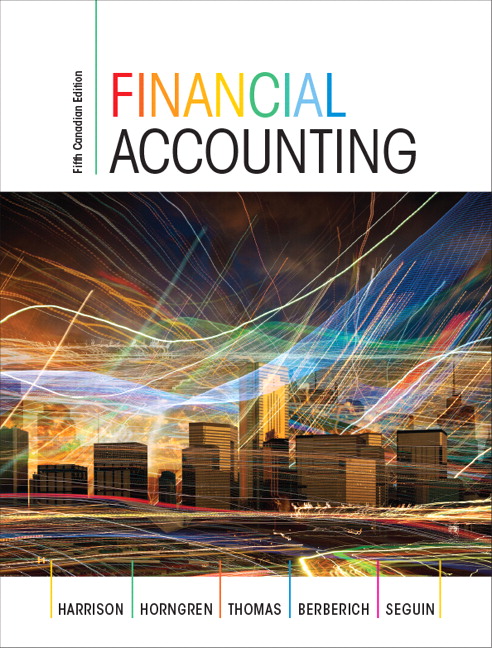Test Bank for Financial Accounting, 5th Canadian Edition, Walter T. Harrison, Jr., Charles T. Horngren, C. William Thomas, Greg Berberich Catherine Seguin
$55.00
Test Bank for Financial Accounting, 5th Canadian Edition, Walter T. Harrison, Jr., Charles T. Horngren, C. William Thomas, Greg Berberich, Catherine Seguin,
You will receive this product within 24 hours after placing the order
Test Bank for Financial Accounting, 5th Canadian Edition, Walter T. Harrison, Jr., Charles T. Horngren, C. William Thomas, Greg Berberich, Catherine Seguin,
You are buying Test Bank. A Test Bank is collection of test questions tailored to the contents of an individual . Test bank may contains the following types of questions: multiple choice, true/false, fill in the blank, matching, essay/short answer, and free-response questions. Please download sample for your confidential. All orders are safe, secure and confidential.
Table of Contents
Chapter 1 The Financial Statements
Explain Why Accounting Is the Language of Business
Explain Accounting’s Conceptual Framework and Underlying Assumptions
Describe the Purpose of Each Financial Statement and Explain the Elements of Each One
Explain the Relationships Among the Financial Statements
Make Ethical Business Decisions
Chapter 2 Recording Business Transactions
Describe Common Types of Accounts
Record the Impact of Business Transactions on the Accounting Equation
Record the Impact of Business Transactions in T-Accounts
Record Business Transactions in the Journal and Post Them to the Ledger
Prepare a Trial Balance
Chapter 3 Accrual Accounting and the Financial Statements
Explain How Accrual Accounting Differs From Cash-Basis Accounting
Apply the Revenue and Expense Recognition Principles
Record Adjusting Journal Entries
Prepare the Financial Statements
Record Closing Journal Entries
Analyze and Evaluate a Companys Debt-Paying Ability
Chapter 4 Internal Control and Cash
Describe Fraud and Its Impact
Explain the Objectives and Components of Internal Control
Prepare and Use a Bank Reconciliation
Apply Internal Controls to Cash Receipts and Cash Payments
Construct and Use a Budget to Manage Cash
Chapter 5 Short-Term Investments and Receivables
Account for Short-Term Investments
Account for and Control Receivables
Estimate and Account for Uncollectible Accounts Receivables
Account for Notes Receivable
Explain How to Improve Cash Flows From Sales and Receivables
Evaluate a Companys Liquidity
Chapter 6 Inventory and Cost of Goods Sold
Account for Inventory Using the Perpetual and Periodic Inventory Systems
Explain and Apply Three Inventory Costing Methods
Explain How Accounting Standards Apply to Inventories
Analyze and Evaluate Gross Profit and Inventory Turnover
Use the Cost-of-Goods-Sold (COGS) Model to Make Management Decisions
Analyze How Inventory Errors Affect the Financial Statements
Chapter 7 Property, Plant, and Equipment, and Intangible Assets
Describe the Types of Tangible and Intangible Assets a Business May Own
Measure and Account for the Cost of Property, Plant, and Equipment
Calculate and Record Depreciation on Property, Plant, and Equipment
Explain Additional Topics in Accounting for Long-Lived Tangible Assets
Account for Intangible Assets
Interpret Tangible and Intangible Asset Activities on the Statement of Cash Flows
Chapter 8 Long-Term Investments and the Time Value of Money
Analyze and Report Non-strategic Investments
Analyze and Report Investments in Affiliated Companies Using the Equity Method
Analyze and Report Controlling Interests in Other Corporations Using Consolidated Financial Statements
Analyze and Report Long-Term Investments in Bonds
Report Investing Activities on the Statement of Cash Flows
Explain the Impact of the Time Value of Money on Certain Types of Investments
Chapter 9 Liabilities
Explain and Account for Current Liabilities
Explainthe Types, Features, and Pricing of Bonds Payable
Calculate and Account for Interest Expense on Bonds Payable
Explain the Advantages and Disadvantages of Financing with Debt Versus Equity
Analyze and Evaluate a Company’s Debt-Paying Ability
Describe Other Types of Long-Term Liabilities
Report Liabilities on the Balance Sheet
Chapter 10 Shareholders Equity
Explain the Main Features of a Corporation
Account for the Issuance of Shares
Explain Why a Company Repurchases Shares
Account for Retained Earnings, Dividends, and Stock Splits
Distinguish Between Fair Value andValue per Share
Evaluate a Company’s Return on Equity Using DuPont Analysis
Report Equity Transactions and Events in the Financial Statements
Chapter 11 The Income Statement, the Statement of Comprehensive Income, and the Statement of Shareholders’ Equity
Evaluate the Quality of Earnings
Account for Other Items on the Income Statement
Compute Earnings per Share
Analyze the Statement of Comprehensive Income and the Statement of Changes in Shareholders Equity
Differentiate Between Management’s and the Auditor’s Responsibilities in Financial Reporting
Chapter 12 The Statement of Cash Flows
Explain the Uses of the Statement of Cash Flows
Explain and Classify Cash Flows from Operating, Investing, and Financing Activities
Prepare a Statement of Cash Flows Using the Indirect Method of Determining Cash Flows from Operating Activities
Chapter 13 Financial Statement Analysis
Perform Horizontal Analysis
Perform Vertical Analysis
Prepare Common-Size Financial Statements
Use the Statement of Cash Flows in Decision Making
Use Ratios to Make Business Decisions












Reviews
There are no reviews yet.